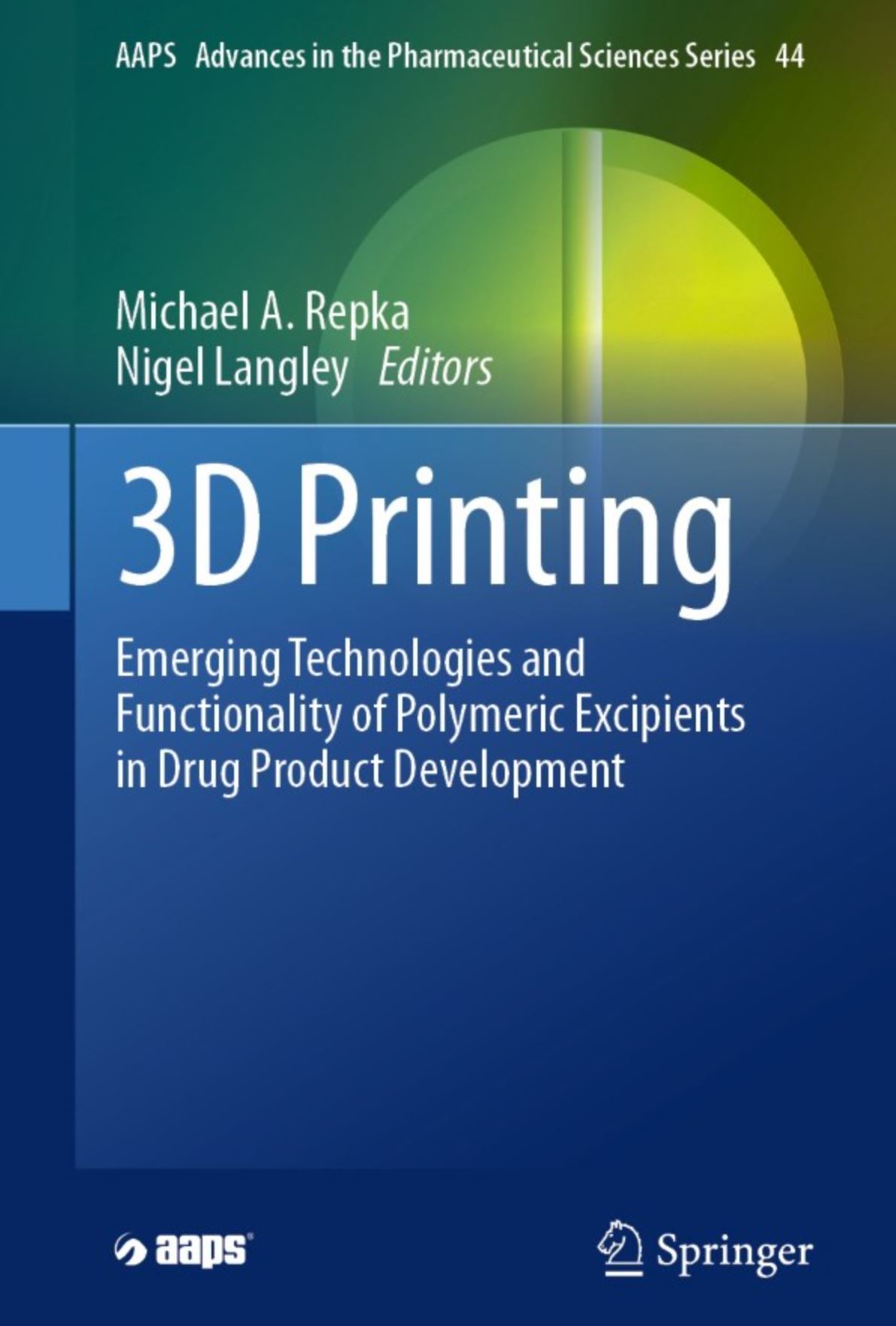3D Printing Emerging Technologies and Functionality of Polymeric Excipients in Drug Product Development – Part 2

See the new book, edited by Michael A. Repka, Nigel Langley
- Covers regulatory and manufacturing aspects of 3D printing in drug development
- Particular focus on hot melt extrusion and extruded filaments suitable for optimizing 3D printing
- Thorough short text and guide for use on the production line of 3D printing of pharmaceuticals
Description:
This inclusive text describes 3D Printing for pharmaceutical applications, including emerging 3D technologies. The book focuses on the functionality of the materials/biomaterials used for the preparation of dosage forms and devices, fundamentals for preparing these systems and novel applications using these additive manufacturing techniques. Also, the text includes clinical relevance and regulatory considerations for the future of personalized medicine.
Authored by experts with a broad range of experience, extensive insight into the science of 3D printing technology used to produce these systems is provided. Highlighting viewpoints from the academic, polymer excipient, equipment, product development and regulatory communities, this comprehensive text compiles input from industry thought leaders to illustrate strategies and technologies for applying techniques of additive manufacturing for drug product and device development while also providing insight into the path forward for the technology in years to come.
Chapter 4
Synthetic Polymers for HME-Based 3D Printing
This chapter focuses on synthetic polymers that have been used either individually or in combination as the matrix materials or plasticizers for fused deposition modeling (FDM) 3D printing. The polymers used for hot melt extrusion (HME) theoretically can be utilized for FDM 3D printing. However, the melt viscosity should be carefully considered as 3D printing is more limited by the printers where the printing tip orifice size is usually small. Plasticizers are usually combined with the matrix polymers to lower the melt viscosity and the printing temperature. Sometimes, functionalities are required to achieve different release patterns, for example, sustained release, delayed release, or instant release. In this chapter, the applications of Soluplus®, Kollidon® IR, Kollidon® SR, Kollidon® VA64, and soluble Kollidon® in FDM 3D printing are summarized.
Zhou, F., Zhang, C., Zhang, J. (2024). Synthetic Polymers for HME-Based 3D Printing. In: Repka, M.A., Langley, N. (eds) 3D Printing . AAPS Advances in the Pharmaceutical Sciences Series, vol 44. Springer, Cham. https://doi.org/10.1007/978-3-031-46015-9_4
Chapter 5
Polymers for Pharmaceutical 3D Printing: Printability and Critical Insight into Material Properties
This chapter offers a focused exploration of the pivotal role of polymers in pharmaceutical 3D printing, delving into both their printability and essential material properties. Highlighting the significance of material selection in achieving successful printing outcomes, the review discusses the interplay between polymer characteristics such as rheology, viscosity, and molecular weight and their impact on printability, including novel polymers. By providing critical insights into how material properties influence the 3D printing process and final product quality, Chap. 5 contributes to an informed understanding of the complex relationship between polymers and pharmaceutical additive manufacturing, facilitating advancements in drug formulation and personalized medicine.
Muehlenfeld, C., Duffy, P., Yang, F., Zermeño-Pérez, D., Durig, T. (2024). Polymers for Pharmaceutical 3D Printing: Printability and Critical Insight into Material Properties. In: Repka, M.A., Langley, N. (eds) 3D Printing . AAPS Advances in the Pharmaceutical Sciences Series, vol 44. Springer, Cham. https://doi.org/10.1007/978-3-031-46015-9_5
Chapter 6
API and Polymer Selection: Formulation and Process Variables
Successful 3D printability depends on various critical parameters. During formulation, ensuring the stability of the active pharmaceutical ingredient (API) while processing and within the 3D-printed dosage forms entails critical components. The major challenge in stability is preserving the API’s physical (crystalline or amorphous) nature. While hot-melt extrusion (HME) offers amorphization of the API, the challenge lies in maintaining the active’s physical and chemical stability, such as the risk of degradation at elevated temperatures. Balancing API-polymer miscibility and leveraging non-covalent interactions become integral strategies for stability. Comprehensive analytical methodologies and real-time monitoring techniques provide valuable tools for stability assessment during formulation and product development. By selectively incorporating plasticizers, antioxidants, and optimal processing parameters, coupled with stringent storage protocols, the journey toward consistent, top-tiered 3D-printed pharmaceutical products is introduced and discussed within this chapter.
Vemula, S.K. et al. (2024). API and Polymer Selection: Formulation and Process Variables. In: Repka, M.A., Langley, N. (eds) 3D Printing . AAPS Advances in the Pharmaceutical Sciences Series, vol 44. Springer, Cham. https://doi.org/10.1007/978-3-031-46015-9_6
See the full book here:
Michael A. Repka, Nigel Langley, 3D Printing Emerging Technologies and Functionality of Polymeric Excipients in Drug Product Development, https://doi.org/10.1007/978-3-031-46015-9, ISBN 978-3-031-46017-3Due: 16 December 2024

